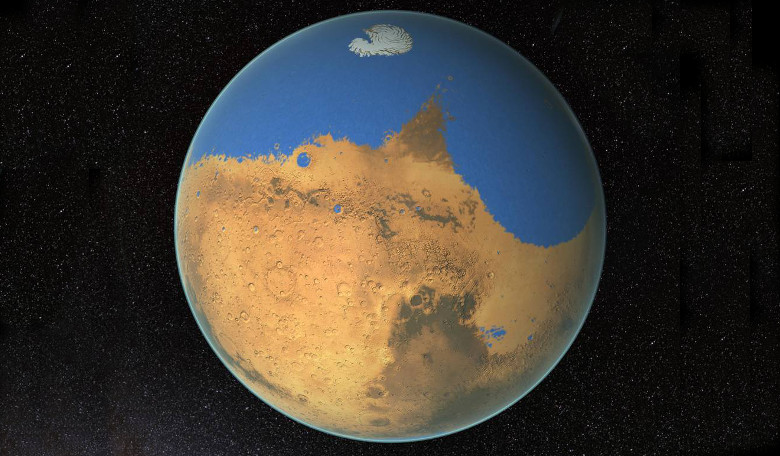Did Mars ever have oceans? And if so, when did they form? These questions have been the subject of scientific research for decades, but now a team of scientists suggest that the red planet’s northern lowlands were indeed teeming with water and as far back as 3.7 billion years ago.
Evidence to suggest that Mars has not always been the dry and barren ball of rock that we associate with today, comes in the form of shoreline-like features; distinct geological boundaries that line the northern plains of Mars for thousands of kilometres.
These have been interpreted in the past as ancient shorelines therefore indicating evidence of an early ocean. However these ‘shorelines’ are not at a constant uniform level but vary by up to several kilometres in height across the plains.
Some scientists have suggested that the shorelines might have changed position after the formation of a vast volcanic plateau known as Tharsis, which changed the face of the evolving landscape.
Tharsis is a 5,000-kilometre-wide eruptive complex containing some of the biggest volcanoes in the Solar system, such as Arsia mons, Pavonis Mons and Ascraeus Mons. If this sizeable plateau formed away from the equator, then the growing mass of Tharsis could have shifted the weight of the planet making it top heavy, so to speak and in doing so, shifted Mars’s pole of rotation at the same time. If this happened, the change in orientation of the planet’s equatorial bulge would cause any oceans to carve out features at different elevations in the landscape.
However there is lots of evidence to suggest that this huge plateau formed near the equator, and this would have the opposite affect, I.e it would stabilise Mars against any changes in its rotation around its own axis.
Now, Robert Citron and colleagues from the University of California have proposed in a letter submitted to Nature today, that oceans were already established as Tharsis began to rise. And, as the plateau grew and the planet’s crust shifted, the oceans carved out new shoreline marks on the northern lowlands rock face as it lifted up.
For this to be case though, it means that Mars’s ocean formed much earlier than thought; one shoreline known as the Arabia shoreline is suggested to have been formed around 4 billion years ago.
What’s more, this hypothesis can also help account for what happened to the oceans, as outgassing – the release of a gas – from Tharsis could have contributed to either heating or cooling of the planet, both of which would have a hand in decreasing the ocean volume. Either way, the uprising of Tharsis, not the affects attributed to after its creation, are the cause say Citron and team.
The team also suggest that maybe the oceans were already in a frozen state before Tharsis was formed and substantial outgassing activity as the plateau was forming, melted the oceans to create the two major shorelines (Arabia and Deuteronilus) seen today.











